
Kim Deitch is an American cartoonist who was an important figure in the underground comix movement of the 1960s, remaining active in the decades that followed with a variety of books and comics, sometimes using the pseudonym Fowlton Means.
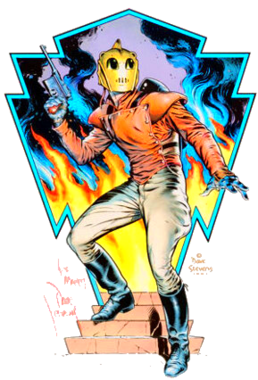
The Rocketeer is a fictional American comic book character, created by writer/artist Dave Stevens. The character first appeared in 1982 and is an homage to the Saturday matinee serial heroes from the 1930s through the 1950s.
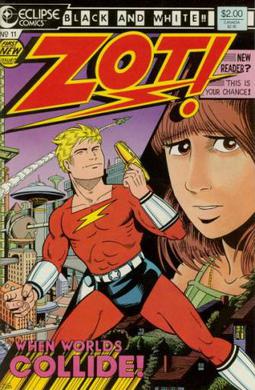
Zot! is a comic book created by Scott McCloud in 1984 and published by Eclipse Comics until 1990 as a lighthearted alternative to the darker and more violent comics that dominated the industry during that period. There were a total of 36 issues, with the first ten in color and the remainder in black and white.

Airboy is a fictional Golden Age aviator hero of an American comic book series initially published by Hillman Periodicals during the World War II, before ending his initial run in 1953. The hero was the costumed identity of crack pilot Davy Nelson II, and created by writers Charles Biro and Dick Wood with artist Al Camy.

Eclipse Comics was an American comic book publisher, one of several independent publishers during the 1980s and early 1990s. In 1978, it published the first graphic novel intended for the newly created comic book specialty store market. It was one of the first to offer royalties and creator ownership of rights.
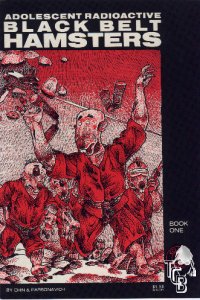
Adolescent Radioactive Black Belt Hamsters is a creator-owned American funny-animal parody comic book series created by Don Chin. It was one of a number of parodies of Mirage Studios' hit Teenage Mutant Ninja Turtles series, itself a parody of popular eighties comics such as Frank Miller's Daredevil and Ronin; others included Naive Inter-Dimensional Commando Koalas and Pre-Teen Dirty-Gene Kung-Fu Kangaroos.

Catherine Anna Yronwode is an American writer, editor, graphic designer, typesetter, and publisher with an extensive career in the comic book industry. She is also a practitioner of folk magic.

Aztec Ace is an American creator-owned science fiction comic book formerly published by Eclipse Comics. Created by writer Doug Moench, 15 issues appeared from 1984 to 1985. Amazing Heroes would describe the series as "a strange cross between Dr. Who and the Illuminati trilogy".

Total Eclipse is an American comic book limited series in five prestige format parts published by Eclipse Comics in 1988 to 1989. A cross-company crossover commemorating the company's tenth anniversary, Total Eclipse was intended to bring all of the company's characters together, no matter how obscure or bizarre. These included Airboy and the Air Fighters, Strike! and Sgt. Strike, Prowlers Leo Kragg and Tim Kida, Aztec Ace, The Liberty Project, Miracleman, The New Wave and Beanish.

Trina Robbins is an American cartoonist. She was an early participant in the underground comix movement, and one of the first female artists in that movement. She is a member of the Will Eisner Hall of Fame.
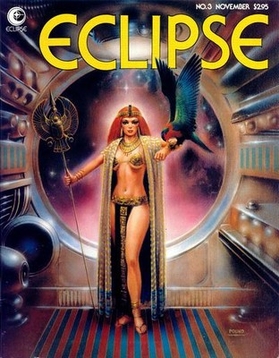
Eclipse, The Magazine was a black-and-white comics anthology magazine published bi-monthly by Eclipse Comics from 1981 to 1983. It was the company's first ongoing title, Eclipse having previously published graphic novels, and was designed as a competitor to the likes of Epic Illustrated and Heavy Metal.

The New Wave was a superhero team comic book published between 1986 and 1987 by Eclipse Comics.

The Liberty Project is a creator owned American comic book series created by writer Kurt Busiek and artist James W. Fry. It was originally published by Eclipse Comics between 1987 and 1988, and concerned a group of super-powered criminals working for the U.S. government in exchange for the possibility of early parole.
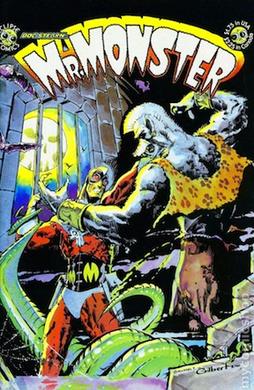
Doc Stearn...Mr. Monster is a comic book featuring a superhero created by Michael T. Gilbert, most recently published by Dark Horse Comics.

Strike! is an American creator-owned superhero comic book series created by writer Chuck Dixon and artist Tom Lyle, published by Eclipse Comics between 1987 and 1988. It concerns about a teenage boy who finds the power harness of Sgt. Strike, a hero that fought for the US in World War II before disappearing.
Angela Bocage is a bisexual comics creator who published mainly in the 1980s and 1990s. Bocage was active in the queer comics community during these decades, publishing in collections like Gay Comix,Strip AIDS USA, and Wimmen's Comix. Bocage also created, edited, and contributed comics to Real Girl, a comics anthology published by Fantagraphics.
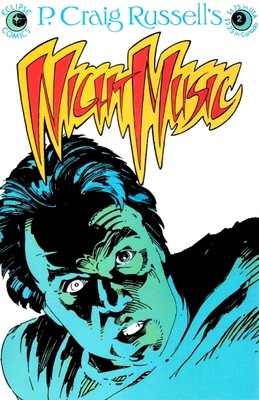
Night Music is an American comic book anthology created by artist P. Craig Russell, published by Eclipse Comics. It consists of comic adaptations of operas, novels, classical music and poems, and followed an irregular publishing model that changed formats according to the needs of the material.

The Prowler is a creator-owned American comic book series created by Timothy Truman and John K. Snyder III. It was published by Eclipse Comics between 1987 and 1988, and chronicled the adventures of 1930s vigilante Leo Kragg, a.k.a. The Prowler, as he trained teenager Scott Kida to take up his legacy.

Misty is a comic book character who has appeared in a series published by Marvel Comics via their Star Comics imprint for younger readers. Created by Trina Robbins, Misty was the star of her own 1985-1986 limited series, Misty, a humour title aimed at young female readers. Following the end of the series, Robbins would make a similar title for Eclipse Comics, California Girls. The character exists in Marvel's main shared universe, known as the Marvel Universe.


















